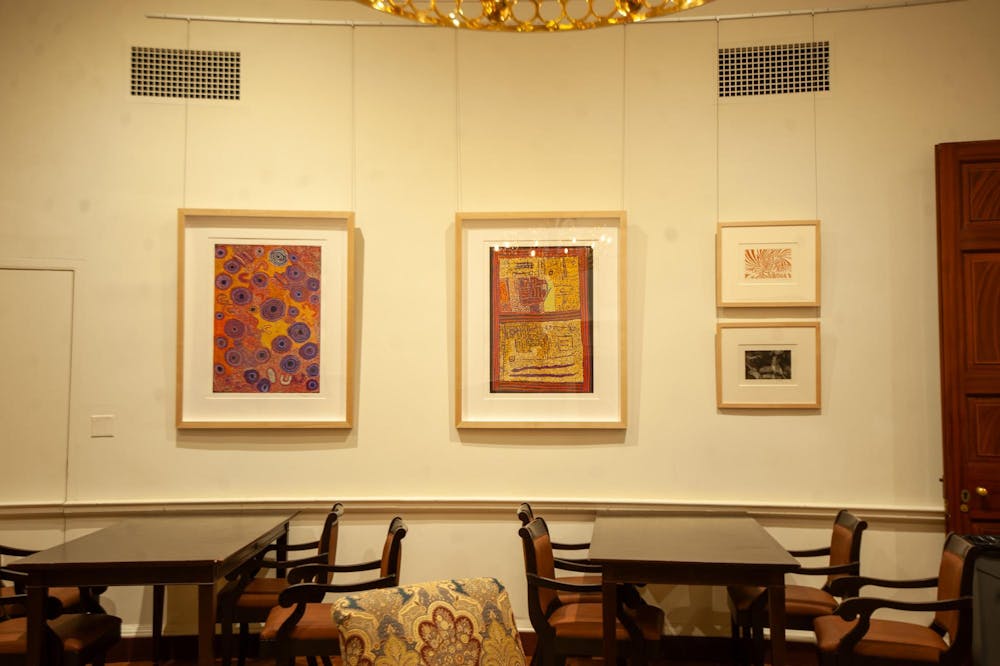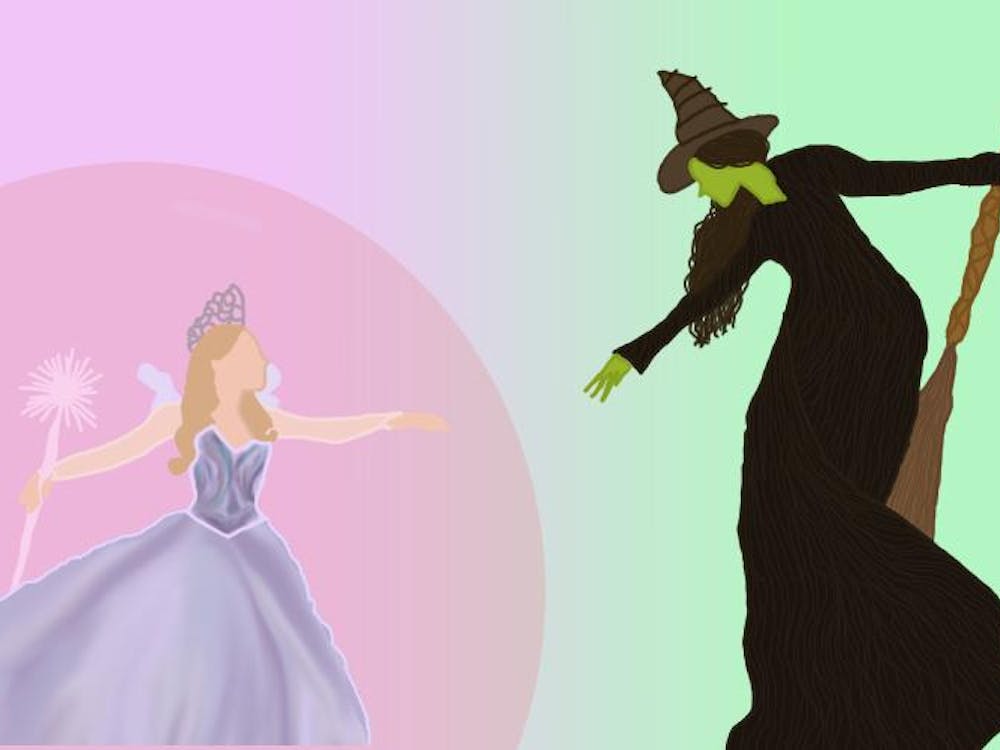Adorning the walls of the Upper West Oval Room of the Rotunda, the vibrant and intricate printmaking pieces of Mimili Maku Arts offer students a way to learn more about the Anangu people of South Australia. The exhibition was curated by Dr. Eleanore Neumann and College graduate student Kathleen King from the Kluge-Ruhe Aboriginal Art Collection, and the prints were all created by members of Mimili Maku Arts, an art center within Australia’s Anangu Pitjantjatjara Yankunytjatjara Lands.
First established in 2010, the art center in South Australia serves as a place to create art, celebrate Anangu values, discuss social issues and provide income to artists through art sales. At its core, the organization is centered on the concept malatja-malatja, which means “those who come after” in Yankunytjatjara. The artmaking process is used as a way for Anangu people to stay connected to their culture while educating and supporting their next of kin.
The exhibition includes eight prints, all but one of which were made during Mimili Maku Arts’ first printmaking workshop in 2012, led by master printmaker Basil Hall. Hall has worked with and donated to Kluge-Ruhe for the last two decades, with these prints being donated in 2023.The selection showcases the strong intergenerational Anangu culture inherent to the spirit of malatja-malatja by highlighting two Anangu families and how they use art to keep stories alive.
Adarsh Shah, Rotunda Ambassador and fourth-year Commerce student, noted that the Rotunda is a uniquely situated space in which to display art from different cultures.
“We're able to have different artifacts from across the world come in at different times,” Shah said. “It's one of the benefits of us being a UNESCO World Heritage Site.”
Most of the prints in the exhibition have a similar style, with vivid points of color combining and layering to create circles, planes and arc-like shapes. Looking closely, each individual point is distinct, but when taking in the entire piece, they create an image that feels alive, reflecting the strength and exuberance of the Anangu community. According to Dr. Neumann, this art style is something that has developed and changed over centuries.
“The work that we’re looking at is an expression of a culture that is the longest continuous culture in the world,” Neumann said. “But like any contemporary artists, they’re also responding to the multiple contexts they live in.”
When selecting prints for this exhibition in March, Neumann and King started with Robert Fielding, Kluge-Ruhe’s next artist in residence. Fielding has his own solo exhibition “Tjukurpa | Handle It” on display at Kluge-Ruhe through Jan. 11.
“In thinking about what else to do around his residency, we decided to put together this exhibition of print so that we could draw more attention to the amazing work being done in his community and show some of the other work that we have in the collection,” Neumann said.
As a member of Australia’s Stolen Generation — a group of children removed from their families due to assimilation policies — Robert Fielding’s father lost the language and stories of his Anangu heritage. Fielding decided to move to Mimili Maku to reclaim his culture, where he met Kunmanara “Mumu Mike” Williams and Tuppy Ngintja Goodwin. They soon became mentors, elders and de facto grandparents for Fielding, and with their help, he raised his children with the Anangu traditions and customs.
Fielding’s print displays winding streaks of white traveling across a black background. This depicts desert sand blowing in the wind, and is intended to be a representation of the past’s neverending flow towards the present.
A print by Fielding’s son, Zaachariaha, is also featured in the installation. Similarly, Zaachariaha’s print makes heavy use of line, displaying layers of red and white stripes converging to the center of the piece. The words “who are you” are etched in Yankunytjatjara both backwards and forwards, signaling a questioning of identity and self.
Kunmanara “Mumu Mike” Williams and Tuppy Ngintja Goodwin each have prints displayed in the exhibition as well. As husband and wife, Williams and Goodwin were both founding members of Mimili Maku Arts and respected community leaders.
Williams helped lead the APY Land Rights movement that returned land to Anangu through the signing of the APY Land Rights Act in 1981. Aboriginal people were first displaced from these lands in the early to mid 20th century, due to the expansion of white settlers and the creation of reserves, which were parcels of land blocked off by the government for Aboriginal people to live.
Within these reserves, the government had complete control over the residents, including when they could leave, where they could work and who they could marry. The APY Land Rights Act was a key piece of legislation giving land ownership back to Aboriginal people.
Williams’ print is the only one not created during Basil Hall’s workshop, and was made in 2019. It features a map of Australia with vibrant red lines emanating from it. Over the map, Williams has written the words “Tjukurpa kunpu mulapa,” translating to “Our culture is strong.”
On the other side of the room, the prints featured are all from one of the most famous lineages of female artists from the APY Lands, including Betty Kuntiwa Pumani, her daughter Marina Pumani Brown and her niece Josina Nyarpingka Pumani. Their prints all reference an important women’s story called the Maku Tjukurpa, which is about gathering enough maku — “witchetty grub” — to feed everyone in the community.
For community leader and founding member of Mimili Arts Kunmamara “Willy Muntjantji” Martin, having a new generation of people experience Anangu culture through art was the entire reason he created prints.
“It’s important that we hold our culture, our stories, our connection to country strong for malatja-malatja — that’s why I make paintings,” Martin said.
One of Martin’s prints is featured in the installation telling the story of the Wati Kutjara Tjukurpa. The fable, passed down to Martin through the men in his family, is about two men who turn into water serpents and travel across Australia. The serpents can be seen clearly snaking across the bottom of the print, their red and purple bodies contrasting against the yellow background.
The installation will be up in the Rotunda until Jan. 11, giving students plenty of time to visit and explore the Aboriginal artwork and culture. Additionally, Robert Fielding will have a conversation open to the public about the Rotunda’s exhibition with indigenous scholar Dr. Gerald McMaster and Kluge-Ruhe director Nici Cumpston in the Upper West Oval Room of the Rotunda on Oct. 2 from 5:00-6:30pm.
Shah believes it is a privilege for the Rotunda to grant students access to such unique and powerful pieces from across the globe.
“These pieces of art could be in any major museum across the world,” Shah said. “We’re lucky to be able to host them here, especially in a place like the Rotunda.”







